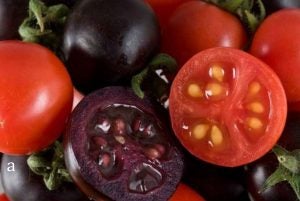A new tomato variety is here: Norfolk Plant Sciences Purple Tomato. The genetically-modified tomato variety has been altered to adjust its color and enhance nutritional quality. On Wednesday, the U.S. Department of Agriculture’s Animal and Plant Health Inspection Service announced that the tomato has passed the first regulatory status response.
The USDA found the plant is unlikely to pose an increased plant pest risk compared to other cultivated tomatoes and is not subject to regulation under 7 CFR part 340. That means, from a plant pest risk perspective, this plant may be safely grown and used in breeding in the United States.

Norfolk’s genetically modified purple tomatoes (Solanum lycopersicum) have high levels of antioxidants and anthocyanins that are typically found in plants such as berries and blackberries. They also exhibit a resistance to kanamycin and neomycin, an antibiotic resistant gene commonly present in GM plants. These traits come from two other plant species — arabidopsis (Thale cress) and antirrhinum (snapdragons).
While there are other purple-skinned tomato varieties already on the market, the levels of purple pigment (anthocyanin) present are significantly lower than those in the NPS Purple Tomato.
Under 7 CFR part 340, developers may submit a request to APHIS for a Regulatory Status Review (RSR) when they believe a modified plant is not subject to regulation.
APHIS reviews the modified plant and considers whether it might pose an increased plant pest risk compared to a non regulated plant. If the USDA’s review finds a plant is unlikely to pose an increased plant pest risk relative to the comparator plant, a response is issued indicating the plant is not subject to the regulations.


